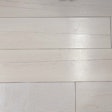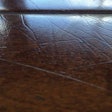The Hardwood Floors Magazine online forum always seems to have heated discussions on various topics. The current discussion on delamination of engineered is a classic example of an "apples" versus "oranges" argument. I would summarize the two sides like this:
1) Delamination of any engineered product is always a manufacturing defect, versus…
2) When site-related relative humidity is allowed to diverge outside of the relative humidity range between 30% to 50%, the delamination of any engineered product is considered site-related and is not considered a manufacturing defect.
The "apples" contingent could be classified as the theoretical position in that any failure of an engineered product would be "caused" by a deficiency in the design and/or manufacturing process. The "oranges" adherents (pun intended) could be classified as the "disclaimer" position in that any failure of an engineered product where the building RH does not stay within the 30% to 50% RH is caused by a deficiency in the building. Both positions are absolute.
Let's look at the "oranges" first. The 30%-50% position is a legal position with some basis in logic. If the end user agrees to limit the RH in the building to 30%-50% then the supplier of the engineered flooring provides some type of structural warranty. There are two intriguing aspects to the 30%-50% limitation. First, it is highly unlikely (I mean really extremely intensely highly unlikely) that the interior of a building will stay within the 30%-50% range all of the time. You can state with near certainty that any delaminated engineered flooring has been subjected to a building RH that is outside the 30%-50% limitation. The second aspect is that engineered flooring with minor defects will probably not exhibit any delaminations if it does not change moisture content and is not exposed to RH outside the 30% to 50% range. You could call the 30%-50% limitation a "Catch-22" proposition or disclaimer. The 30%-50% rule is simple and elegant and almost impossible to comply with.
The "apples" argument blaming all delaminations on the supplier is also potentially flawed. Any experienced competent installer will tell you that engineered wood flooring can't be handled with the same brute force as solid unfinished flooring. A "quick" reading of any textbook on wood bonding will clear up the misconception that evaluating "delaminations" is a simple matter. The possibilities of breakage during handling and installation of engineered flooring add another layer of complexity to the task. Evaluating adhesive bonds is often accomplished using a microscope or other magnification and based on considerable experience and training.





























